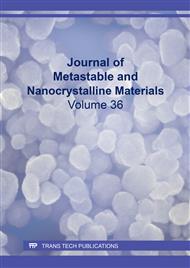[1]
Y.Y. Ju, Q.M. Zhang, Z.Z. Gong, G.F. Ji, Molecular dynamics simulation of shock melting of aluminum single crystal, Journal of Applied Physics 114 (2013) 093507.
DOI: 10.1063/1.4819298
Google Scholar
[2]
I.A. Bryukhanov, Atomistic simulation of the shock wave in copper single crystals with pre-existing dislocation network, International Journal of Plasticity 151 (2022) 103171.
DOI: 10.1016/j.ijplas.2021.103171
Google Scholar
[3]
S.K. Singh, A. Parashar, Effect of lattice distortion and nanovoids on the shock compression behavior of (Co-Cr-Cu-Fe-Ni) high entropy alloy, Computational Materials Science 209 (2022) 111402.
DOI: 10.1016/j.commatsci.2022.111402
Google Scholar
[4]
T. Wang, F.X. Zhou and Y.W. Liu, A Lennard-Jones embedded-atom potential and its application to the study of melting, Chinese Phys. 11 (2002) 139.
Google Scholar
[5]
K. Kadau, T.C. Germann, P.S. Lomdahl and B.L. Holian, Microscopic view of structural phase transitions induced by shock waves, Science 296 (2002) 1681-1684.
DOI: 10.1126/science.1070375
Google Scholar
[6]
Y. Chen, Z.Y. Jian, S.F Xiao, L. Wang, X.F. Li, K. Wang, H.Q. Deng and W.Y. Hu, Molecular dynamics simulation of shock wave propagation and spall failure in single crystal copper under cylindrical impact, Appl. Phys. Express 14 (2021) 075504.
DOI: 10.35848/1882-0786/ac06de
Google Scholar
[7]
Y.T. Wang, X.G. Zeng, X. Yang, T.L. Xu, Shock-induced spallation in single-crystalline tantalum at elevated temperatures through molecular dynamics modeling, Computational Materials Science 201 (2022) 110870.
DOI: 10.1016/j.commatsci.2021.110870
Google Scholar
[8]
P.Wen, G. Tao, D.E. Spearot, S.R. Phillpot, Molecular dynamics simulation of the shock response of materials: A tutorial, Journal of Applied Physics 131 (2022) 051101.
DOI: 10.1063/5.0076266
Google Scholar
[9]
Z.Y. Jian, Y.C. Chen, S.F. Xiao, L. Wang, X.F. Li, K. Wang, H.Q. Deng, W.Y. Hu, Molecular dynamic simulations of plasticity and phase transition in Mg polycrystalline under shock compression, Applied physics express 15 (2022) 15503.
DOI: 10.35848/1882-0786/ac43e3
Google Scholar
[10]
X.Yang, S. Xu and L. Liu, The shock response and spall mechanism of Mg–Al–Zn alloy: molecular dynamics study, Acta Mech. Solida Sin. 35 (2022) 495–503.
DOI: 10.1007/s10338-021-00301-4
Google Scholar
[11]
L. He, F. Wang, X.G. Zeng, X. Yang, Z.P. Qi, Atomic insights into shock-induced spallation of single-crystal aluminum through molecular dynamics modeling, Mechanics of Materials 143 (2020) 103343.
DOI: 10.1016/j.mechmat.2020.103343
Google Scholar
[12]
Garvit Agarwal, Avinash M. Dongare, Defect and damage evolution during spallation of single crystal Al: Comparison between molecular dynamics and quasi-coarse-grained dynamics simulations, Computational Materials Science 145 (2018) 68-79.
DOI: 10.1016/j.commatsci.2017.12.032
Google Scholar
[13]
J.R. Asay and L.C. Chhabildas, in High-pressure shock compression of solids VI, edited by Y. Horie, L. Davison, and N.N. Thadhani, Springer: New York, 2003, Chap. II.
DOI: 10.1007/978-1-4613-0013-7
Google Scholar
[14]
J. Mei, J.W. Davenport and G.W. Fernando, Analytic embedded-atom potentials for fcc metals: application to liquid and solid copper, Phys. Rev. B 43 (1991) 4653.
DOI: 10.1103/physrevb.43.4653
Google Scholar
[15]
Y.M. Gupta, J.M. Winey, P.B. Trivedi, B.M. LaLone, R.F. Smith, J.H. Eggert and G.W. Collins, Large elastic wave amplitude and attenuation in shocked pure aluminum, J. Appl. Phys. 105 (2009) 036107.
DOI: 10.1063/1.3075839
Google Scholar
[16]
Y.Y. Yu, H. Tan, J. B. Hu, C.D. Dai and D.N. Chen, Measurements of sound velocities in shock-compressed tantalum and LY12 Al, Explosion and Shock Waves 26 (2006) 486-490. (in Chinese)
Google Scholar
[17]
S.P. Marsh, LASL Shock Hugoniot Data, University of California Press: Berkeley, 1980.
Google Scholar
[18]
V. Tomar and M. Zhou, Molecular dynamics modeling of shock wave propagation in fcc-Al, α-Fe2O3, AIP Conf. Proc. 845 (2006) 421-424.
DOI: 10.1063/1.2263351
Google Scholar
[19]
E.M. Bringa, A. Caro, M. Victoria and N. Park, The atomistic modeling of wave propagation in nanocrystals, JOM 57 (2005) 67-70.
DOI: 10.1007/s11837-005-0119-9
Google Scholar


